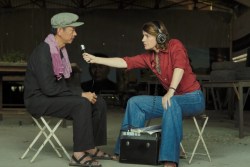I’ve never seen a line for the men’s room at the American Cinématheque as long as the one that confronted me at intermission of the marathon screening of Zack Snyder’s “Rebel Moon” this weekend. (Keep in mind, by that point, the crowd had been holding its collective bladder for three and a half hours, with the second half still to come.) Meanwhile, there were so few women in attendance that the ladies’ room had practically no wait at all — a phenomenon that said everything about the crowd that had turned out for a big-screen look at the 373-minute director’s cut of Snyder’s two-part space opera.
To call this roided-out macro-edition of “Rebel Moon” a “director’s cut” is to willingly buy into Netflix’s egregious misrepresentation of a project that had been conceived to exist in two separate versions all along: a by-no-means-neutered and still-plenty-aggro PG-13 version, and now this, a much longer and far gorier cut, crammed with exploding-head carnage so repetitive it starts to be tiresome, along with great big gratuitous helpings of nudity, sex and backstory — hardly any of which materially alters the underlying story.
“Rebel Moon” is terrible any way you slice it. As Snyder warned during the post-screening Q&A, “There are another four, five movies beyond this.” And that’s not all: “There’s this animated movie that we’ve been working on,” he added. “I don’t know if we’re going to make it 100%, but we’re working on it.” So it really comes down to how much time you want to invest in watching Snyder try to cosplay George Lucas.
Popular on Variety
Frankly, I think “The Fifth Element” director Luc Besson makes for a better comparison, seeing as how both he and Snyder think like 13-year-old boys. While they’re competent enough behind the camera, their imaginations seem stunted by the onset of puberty. In “Rebel Moon,” we find Snyder attempting to out-imagine all the sci-fi minds who’ve come before, but ultimately limited by his fascination with boobies. It’s like watching an ambitious kid world-building with borrowed Legos. You want to see whether he can come up with anything original.
In the end, there’s no one to blame but Snyder, since Netflix gave him creative control of both versions (though Peter Jackson bears some responsibility, having established this infernal precedent with his extended cuts of “The Lord of the Rings”). Compare that experience to the satisfaction of seeing what Snyder had intended to do with “Justice League.” When Snyder suffered a personal tragedy, director Joss Whedon stepped in to finish that epic DC adaptation. Four years later, it felt like a genuine victory over a gun-shy studio to get “The Snyder Cut.”
By contrast, Snyder’s turbo-charged “Rebel Moon” re-releases are no kind of artistic triumph at all. If anything, knowing he’d be allowed to put out bigger, longer, “uncut” versions seems to have discouraged Snyder from making the sort of decisions necessary to craft a coherent, well-paced space opera in the first place.
Like such never-satisfied auteurs as Francis Ford Coppola and Oliver Stone, “Zack is a director who is known for director’s cuts,” Zack’s wife and producing partner, Deborah Snyder, announced from the stage before the show at the Cinematheque’s Egyptian Theatre (which is now owned by Netflix), eliciting a roar of approval from the cult-like crowd. Judging from the looks of it, the room was packed with the sort of middle-aged, overwhelmingly male mob one finds at Comic-Con — or a subset of those who hadn’t caught COVID in San Diego the weekend before.
“When we first came to Netflix,” Deborah Snyder went on to explain, “it was [then-chairman] Scott Stuber who said to us, ‘What if you get to do both? What if we can do something that our kids can see, and what if we can do something that the hardcore fans are expecting from you — but we plan for it?’”
To be clear, I did not come to this event as a fan. I came as a “cinemasochist,” which is to say, someone who takes pleasure — although “pride” would probably be more apt — in sitting through long and arduous movies. Here, the running time qualifies, though I sincerely hoped to have a good time. The pleasure of the PG-13 release comes from its set-pieces (Nemesis taking on Jena Malone’s eight-legged ogumo, Tarak taming the griffin-like bennu), but the connective tissue is missing. Maybe the longer version could restore that, or make the whole thing make sense.
Snyder has satisfied me only twice as a director: His terrifying, character-driven 2004 take on “Dawn of the Dead” played a pivotal role in the 21st-century zombie revival (I doubt we would have gotten “The Walking Dead” without it), and there’s no denying how visionary his grungy Physique Pictorial adaptation of Frank Miller’s “300” felt at the time. It made a swarthy new action star of Gerard Butler, while demonstrating the expressionistic possibilities of CGI when so many directors were striving for realism.
At that point in his career, Snyder felt like a man of original ideas, when in fact, time has revealed him to be just another remix artist, appropriating other people’s IP. And then came “Sucker Punch,” after which watching Snyder’s work began to feel like a chore. It was in that spirit that I picked up a friend and drove all the way out to Pacific Palisades to see “Rebel Moon: A Child of Fire” seven months earlier. It was screening on the big screen at one Los Angeles venue, The Bay, where the two of us had the theater to ourselves.
That’s right, when Netflix released the first part of Zack Snyder’s “Rebel Moon,” hardly anyone went. Let’s charitably assume that the theater was empty that day because “hardcore fans” were waiting for the unrated director’s cut.
In fact, The Bay is a swanky art-house venue half an hour from Netflix HQ which the streamer uses to host Oscar-qualifying “theatrical runs” of its movies. This is because Netflix “content” (as they call it) can’t compete for Academy Awards if the company dumps it directly onto streaming. But Scott Stuber and his successors don’t really want you to see their stuff on the big screen, so they make it as difficult as possible to do so.
Nor can you own them in any home-video format, which means, if you want to see the director’s cut of “Rebel Moon,” you have to do so on Netflix. Or else, you had to be in the room with us on Saturday night, where the crowd’s anticipation was so palpable, you’d think we were about to witness the next episode in the “Star Wars” franchise — which, far more than a live-action “Heavy Metal,” is clearly what Snyder set out to make with this spare-parts space opera. The director takes himself entirely too seriously, depriving audiences of the levity and occasional comedy that would make six hours of space genocide bearable.
Zack and Deborah Snyder have been doing the rounds, telling press that these are “literally four different movies,” a claim which is disingenuous in theory and downright misleading in truth. Last year’s “ultimate cut” of “Caligula” is a different movie from the colossal debacle that Penthouse honcho Bob Guccione released back in 1980, in that not a single shot was repeated from the earlier X-rated version (in practice, that amounted to using second-best or slightly-less-histrionic takes to return “Caligula” to the film that screenwriter Gore Vidal set out to make).
The new release of “Rebel Moon” also features alternate takes of certain shots (namely those that would have been too violent to qualify for a PG-13 rating from the Motion Picture Association), but it’s essentially the same movie, just a lot more explicit. I mention “Caligula” because that notorious movie flashed through my mind during the new 20-minute set-piece with which Snyder opens his now-unrated, slightly-retitled “Rebel Moon — Part One: Chalice of Blood”. Rather than beginning on the rebel moon of Veldt, Snyder kicks off with space-Nazi Admiral Atticus Noble (Ed Skrein), kinky errand boy for the Motherworld, landing on another moon entirely.
As he strides across the burning ancient Rome-looking city of Toa, we hear screams of subjugation on the soundtrack. Lest the invaders’ depravity be in doubt, we see Atticus’ men stripping the city’s “so-called priestesses” and marking their bare breasts with a branding iron. A tracking shot depicts one toga-clad Toan kneeling in the foreground with a gun to the back of his head, the first example of what will soon become this film’s “mind-blowing” signature: a lava-hot laser beam hits someone’s skull, popping his nob like a thin-skinned tomato, and splattering everything (including the lens) with CG marinara.
The MPA won’t let you do that in a PG-13 movie, but there’s nothing to stop Snyder here — no child-protecting overlords, and certainly not good taste. If you’re looking for a drinking game to play along with the “Rebel Moon” director’s cuts, I suggest taking a swig every time someone’s brain bursts. Just be sure to keep the ER on speed dial, since alcohol poisoning is all but assured.
Audiences don’t really need this newly restored Toa scene to establish Atticus’ villainy, though it does serve to introduce the character of Aris (Sky Yang), reminiscent of Finn (John Boyega), the reluctant Stormtrooper in “The Force Awakens.” Though Aris was but a minor character in the earlier version, here we see Atticus force the young man to make a cruel — and ultimately irrelevant — choice: He must decide which of his family members to kill (irrelevant because, unbeknownst to Aris, Atticus fully intends to slay them all). Cue the film’s second exploding head, as Aris smashes his dad’s skull.
But Snyder doesn’t stop there. Atticus stoops down and scoops up a bit of brain matter, taunting the man’s widow as he squeezes the mushy “memories” between his fingers. As if that wasn’t already a touch too much, one of Atticus’ “Scribes” (the crimson-cloaked priests with broad, discus-shaped hats who look suspiciously like Darth Vader’s Red Guards) extracts a molar from the dead man’s mouth and inserts it into a framed photo of the Princess Issa (the slain savior who now motivates the Motherworld’s unholy war).
“Obviously, we have more teeth in this movie,” Snyder laughed more than eight hours later, unsure how to explain the significance of his “dental obsession”: “The soul is in the teeth … could be?” he said, before admitting, “It just seemed cool,” which is clearly the real reason behind most of his creative choices: They just seemed cool to him at the time.
Now, I don’t want to diminish how impressive so many of the elements that Snyder and his design team concocted for “Rebel Moon” can appear. But why does such inspiration matter when the script itself feels so derivative? Judging by the long, sycophantic Q&A (with the film’s “speculative civilization” advisor Adam Forman) that followed the two-part screening, Snyder has put enormous thought into the mythology and lore that underpins “Rebel Moon.” But that made it all the more exasperating to hear him describe ideas that don’t come through, despite the maximalist project’s miniseries-length running time.
From Quentin Tarantino lifting details from a century of B movies to make “Pulp Fiction” to the way rap music works, sampling and remixing are the dominant modes of expression in modern — and especially postmodern — art. But that tactic only works when the result seems fresh, as if its creator has made something new and original from so many recycled parts.
Jimmy, the android with the existential crisis, is so clearly a C-3PO knockoff that it’s hard not to laugh as he goes wandering through wheat fields with a crown of antlers on his head, looking for purpose (we can guess that he’ll find it just in time to be heroic). At least C-3PO was voiced by Anthony Daniels, who brought an element of comedy to his dusty corner of the galaxy, whereas it’s Anthony Hopkins who reads Jimmy’s lines, sounding dead serious as his blank-faced CG avatar gazes up at the stars and, in the film’s inadvertently funniest scene, steals a cloak from a scarecrow in over-dramatic slow-motion.
The movie’s ostensible hero (of which there are several) is Sofia Boutella’s Kora, aka Arthelais, aka “The Scargiver,” which was also the name of Part Two in the PG-13-rated release (the three-hour version goes by the less-catchy “The Curse of Forgiveness”). Kora’s a flawed character, uncertain of her abilities, but also fearful of her destructive potential — all qualities that make her more compelling and relatable than the various he-men she’ll later enlist in her mission.
Snyder’s male warriors are dull and one-dimensional by comparison, the casting lazily consistent with characters they’ve played in the past. In nearly all cases, their outfits (or lack thereof, in the case of “Game of the Thrones” stud Staz Nair) are more imaginative than their personalities.
Playing Kai, the movie’s shifty Han Solo stand-in, “Sons of Anarchy” star Charlie Hunnam is clearly a lot colder than Nair’s underdressed Tarak, who wouldn’t dream of covering his abs. Hunnam piles on rings, chains and weird dental jewelry, plus a trench coat, a scarf and an uneven Irish accent, none of which can hide Kai’s all-too-obvious secret.
Kora has two potential love interests — and two drawn-out sex scenes, one with each of her suitors, in the extended cut. The idea that she has her choice of suitors (and the option to reject them both) in Veldt’s patriarchal, futuro-Amish system no doubt registers as “feminist” to Snyder, although his treatment of women is far too fetishistic for that label to be convincing.
The director has gone back and added gnarly scar tissue to Kora’s exposed torso in Part One, and he inserts a surprisingly generic three-minute lovemaking sequence between Kora and Gunnar (Michiel Huisman) into Part Two — just another way in which the film is meant to seem more extreme. It’s a weirdly pro forma sex scene, slowing down the protracted first act of “The Curse of Forgiveness,” during which the Viking-like people of Veldt have just three days to harvest all their grain before Atticus’ ship returns. If they’re in a hurry, you wouldn’t know it by all the slow-motion farming footage, in which Snyder channels Terrence Malick and Ukrainian silent-film master Aleksandr Dovzhenko (namely, “Earth”) in equal measure.
I’m not sure Snyder was thinking of the latter when directing this scene, though his brain seems to operate a lot like artificial intelligence does: It takes in centuries of human creativity, and without bothering to assimilate it, reconfigures those ingredients into something that passes for originality. I’m not sure anyone in the room was buying it, though that didn’t stop an adoring mob from forming around Snyder during the hour-long intermission between parts one and two.
To be fair, “Star Wars” operates on much the same philosophy. But whereas “A New Hope” was a thrilling rehash of Joseph Campbell, “John Carter of Mars,” Frank Herbert’s “Dune” and Akira Kurosawa’s “The Hidden Fortress,” sparking a near-religious following, “Rebel Moon” feels like what it is: a garish pastiche of all that has come before. The idea that Snyder has four or five of these (and potentially an animated feature too) up his sleeve seems destined to turn even his most hardcore fans into cinemasochists.













